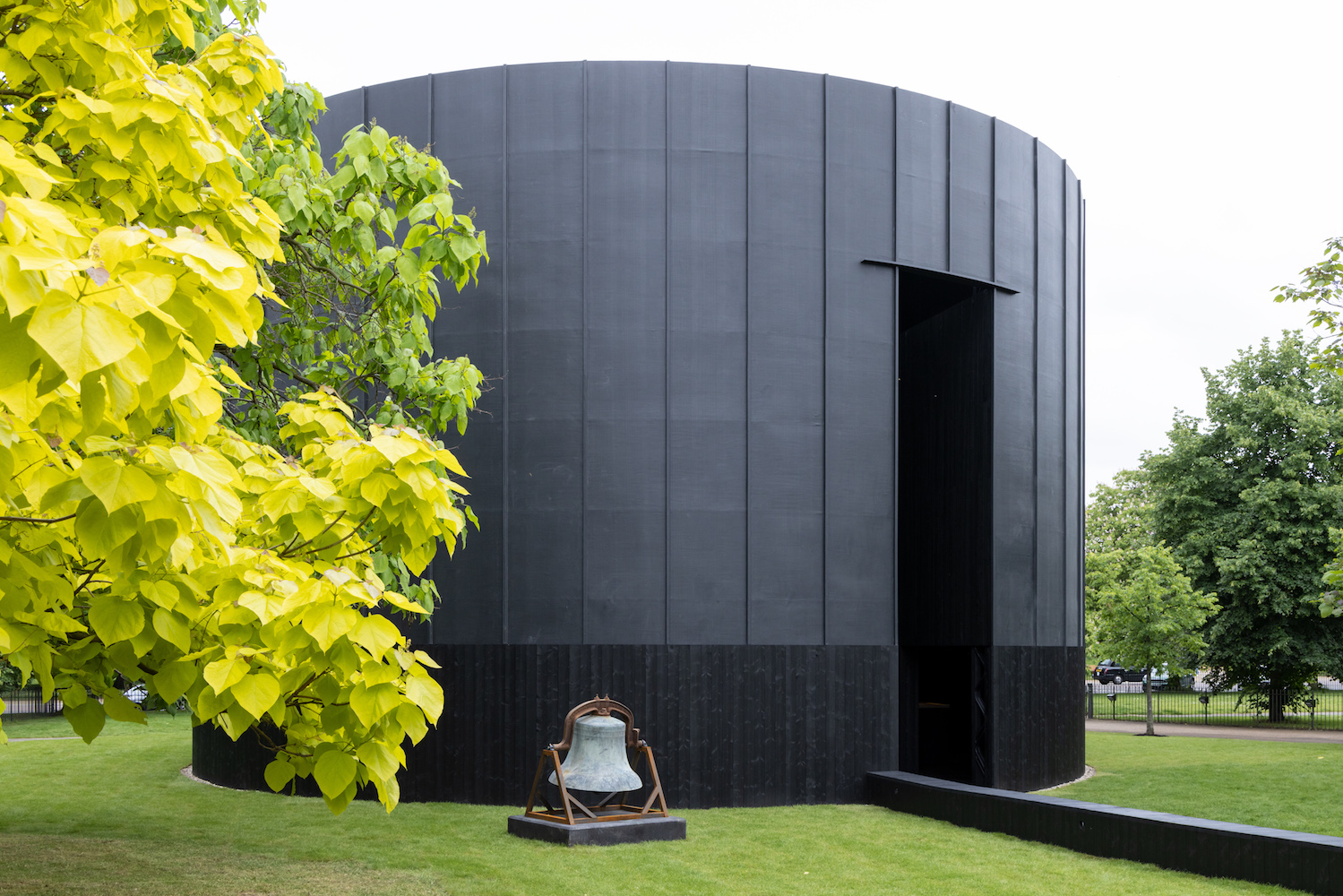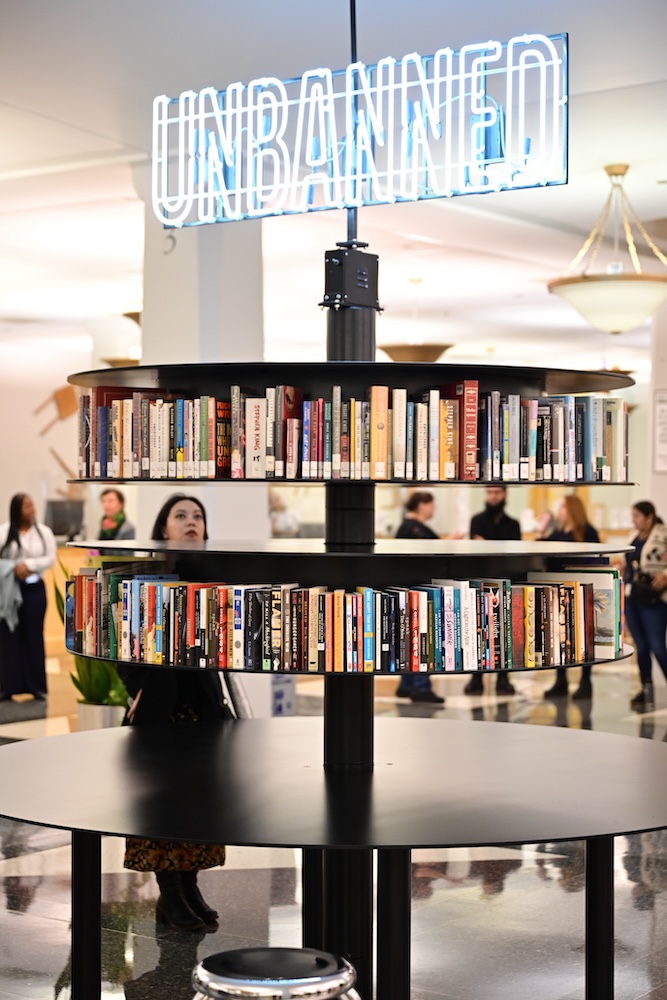An unusual sacred space, the somber, timber, clad cylinder of Black Chapel rises from the lawn of Kensington gardens. Hollow and imposingly tall, draped in a barrel-shaped surface of burnt-shaded wood, the structure represents this year’s Serpentine Pavilion and 21st edition, contrived by Chicago-based artist Theaster Gates, encompassing a wide span of early architectural inspirations that alternate between the silos and granaries of Midwestern agriculture, the bottle kilns of Stoke-on-Trent, the Roman tempiettos of San Pietro, and African building structures such as the Musgum mud huts of Cameroon and the Kasabi Tombs of Kampala, Uganda.
An ode to making, the shape commemorates the myriad of industrial architectural heritage in the business of labor, paying tribute to the topology of working structures, as well as (if not more) the people inside them. And, as with much of Gates’s work, the root of his concept finds its home in ceramics.
Chicago-based Gates was first a potter, later training in urban planning, religion, and ceramics, a culmination of which can be found all across his multidisciplinary practice today, which combines space, architecture, sculpture, and material into one.
The Serpentine Pavilion follows the artist’s Question of Clay (2021-2022), a multi-institution project that took place from 2021 to 2022, comprising exhibitions at the Whitechapel Gallery, White Cube, and a two-year long research project at the Victoria & Albert Museum that investigated the making, labor, and production of clay, as well as its collective history. In Black Chapel, Gates extends this study to a new plane, a new canvas—one people can walk through and around in—allowing his audience to inhabit the space he creates while ennobling the British pottery and manufacturing traditions and structures from which they stem.
With 15 years of expertise making pots of all shapes and sizes, materials, and meanings, Gates learned how to make great things out of something common: clay. Black Chapel marks the first time the coveted architectural commission has been given to an artist, one who leaves room for modesty in his omission of architectural elaboration and trickery.
Minimalistic in design, sound in structure, the monument of craftmanship circumvents the architectural complexes so strongly characteristic of the pavilion’s 21-year history. Conceived as a place for gathering, meditation and participation, the innate humility that rises from the surface gives space for the true purpose the artist had intended, a “vessel,” in essence built to bring people together, where the architectural framework is only meant as backdrop to its function.
Well-versed in the significance of material to embody meaning, Gates adds a touch of the personal, with a dark roofing membrane paying tribute to his father, honouring his trade as a roofer. Part industrial, part spiritual, the pavilion serves as both an homage and memorial, like a funeral chapel inside a gasometer intended as a sanctuary for all.
From afar, something ethereal unfolds from the enigmatic and idiomatic structure, sinister in its stark darkness while empyrean in its absorption and distortion of surrounding light. Divided by an off-center wall, the inner space reverberates with rays of transient geometrical shapes, casting circles and triangles alike, “furthering something elemental,” said Gates. Expelled through irregularly spaced openings: two apertures on either side and a three-meter oculus in the center of the pavilion’s ceiling, light sifts through the unsymmetrically divided space, and amongst a backdrop of drenched inky black stain and transient lighted shapes, seven lined silver squares shimmer with reflected light.
A late edition to the pavilion, these would be Gates’s “Tar Paintings,” made from layers of blowtorched silvery bitumen roofing material (torchdown), hanging side by side, one by one from the interior structure. Transplanting the roofing techniques he learned from his father, Gates translates labor into art, referencing the dome of the pantheon in Rome as he shows yet another example of how discarded materials can be used for a purpose.
Light where the clay works are heavy, and light where the charred tone of the timber is dark, asymmetries and perplexities fill the space, breathing multiple meanings and interpretations, acting as a catalyzer for reflective thought. Spare but minimal, contrast fills the contemplative space, sitting under an oculus spilling light, intensifying our connection to the skies or heavens above.
A space for people of all beliefs, the transcendental environment of Black Chapel draws its inspiration from the Rothko chapel in Houston, Texas, a place dedicated to spirituality that lies outside of the church. “As a built form and conceptual proposition, Black Chapel synthesizes Theaster’s long standing commitment to fusing the secular with the sacred,” said Yesomi Umolu, Director of Curatorial Affairs and Public Practice.
Outside, a restored bronze bell salvaged from St. Laurence, a landmark catholic church on the South side of Chicago, sits beside the chapel on the luscious green grass. Acting as a call to assembly, the bell is ceremonially rung, first by Gates, heralding the summer’s program of live events, beckoning visitors far and near alike towards an artistic exploration of the monastic. Throughout the course of the summer, the curriculum explores sound and song through layered pianos, allowing dance, poetry, and pottery workshops to make the space reverberate. While also serving as an emblem to underline the erasure of spaces for convening and spiritual communion in urban communities, Black Chapel, Umolu suggests, “invites the public to take respite in the pavilion’s hallowed chamber,” to “lose themselves in the reverberations of voice and instrumental.”









